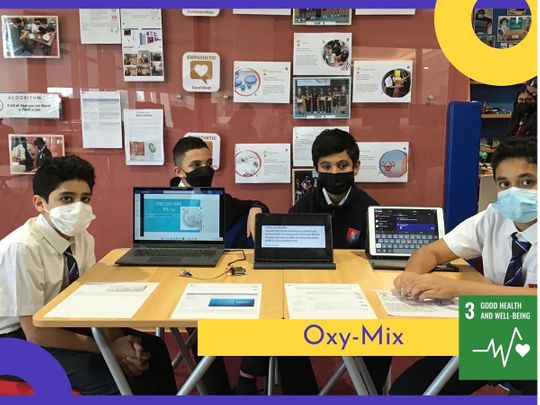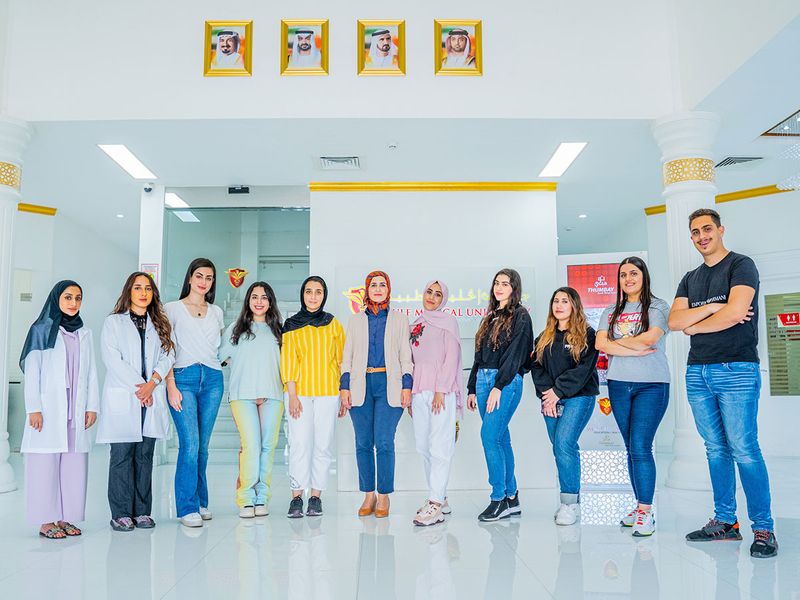
Dubai: The conducive academic atmosphere of the UAE has helped inspire numerous students to push the boundaries of creativity and think out of the box.
A case in point includes two artificial intelligence (AI)-based projects — one by a group of school students and another by a group of dental college students -- designed to serve the community. Here’s a look at them:
Meet the Oxy-mix team: Seeking to enable anywhere, anytime oxygen delivery
This is a unique oxygen delivery mask with sensors using Internet of Things to connect to health-care centres. It was developed by teenagers from GEMS Founders School — Al Mizhar, under the guidance of their teacher, Saba Adnan, the director of Innovation, at the school. The device meets the criteria for fulfilling UAE’s Sustainable Development Goal No 3 for health care and wellbeing.
Overwhelmed by the impact that COVID-19 had on people, five young boys — Egyptian expatriates Giorgio Abdo, 13, Yahia Awad, 12, Omar Anwar, 12, Maalik Ahmed, 12, and British expatriate Azaan Adnan, 12 — to come up with a unique, cost-effective oxygen delivery system.
Team Oxy-mix wanted to play a role in supporting and saving the lives of patients who were dying due to oxygen deprivation. They learnt that when oxygen saturation fell, many patients passed away due to lack of oxygen cylinders or for not being able to make it to the medical facility on time. They wanted to build a device that would be as easily available as masks and at the same time could be controlled by professionals to ensure oxygen supply. The idea was to overcome limited oxygen supply, number of doctors and hospital facilities. Oxy-mix can also be used in treating cases of asthma, chronic obstructive pulmonary disorder (COPD) and even cancer.
How Oxy-mix works
Elaborating on the device for which the students are applying for a patent and have worked out its cost to Dh500 per device, they said: “The Oxy-mix prototype we created is an innovative pocket device with a CO2 [carbon dioxide] Sensor that monitors the patient’s environment and sends data through IOT (Internet of Things) to their doctor or health facility. It is a mask with an in-built mechanism for oxygen release that is controlled by the doctor/health facility. Through it, a patient is supplied with the prescribed oxygen dose (just like an Oxygen Concentrator, but cheaper and controlled by a professional). This can be used by patients who have a weak respiratory system or in cases where an individual experiences a drop in his or her oxygen saturation level and requires external support.
The device contains a third feature, which is of specific use for cancer patients. The students said: “This is based on ‘Oxygen Therapy’, where high-concentrated oxygen supply over a period of time helps in eliminating acidic body environment, which in turn helps in preventing the spread of cancer in the body. This can be achieved through the same mask under a specified oxygen supply prescription or programme by the doctor.”
Inspired mentorship
Adnan, the director of innovation at the school, guided the students in their project. Expressing gratitude to her guidance, they said: “When we shared the idea of the device with our teacher, Saba Adnan, she guided us to the potential application of IOT. She helped us sustain our interest and passion over a long period for the project. She also helped us connect COVID-19 patients at medical centres and their doctors who could monitor oxygen supply and patient vitals to ensure that the patient got the correct quantity of oxygen, as an oversupply can also lead to lung issues.”
Adnan also helped the Oxy-mix team to connect with industry experts who helped them develop the C02 Sensor and its use in association with Micro bit to detect the need of oxygen supply that could alert the necessary health-care centre through IOT.
The students pointed out that their device was an improvement over the existing respiratory devices such the CPAP used for oxygen delivery.
“In contrast to CPAP, which only supports patients with sleep apnea, Oxy-mix helps in various oxygen supply-related issues. In addition, the device allows itself to be connected with a medical centre through IOT, ensuring professional care and alerts medical teams in case an ambulance is needed.”
“Our idea is to save lives by providing oxygen supply in an easy and cost-effective way. Our idea can provide a device to ensure oxygen supply at minimal cost and ensure professional medical supervision for a large number of people without the need to crowd at hospitals. It is also the cheapest device available in the market,” they added.
Smilano, the Smile-Design project
Eleven students from the College of Dentistry at the Gulf Medical University, Ajman, led by Fatima Abdul Rehman, a 20-year-old Iraqi expatriate student in the fourth year of dentistry, came up with Smilano. This is a digital software and web-based application based on deep learning and machine learning, that can be used by dentists to correct smiles as per an individual’s face symmetry.
The AI-based tool can help gauge the vertical and horizontal proportions of a person’s face through the images and provide a correctional treatment plan. The project focuses on analysing the patient’s facial proportions and compare it with a hundred stored images to come up with a proposal for an ideal ‘smile design’ that suits the patient.

One of the unique aspects of this project is its time-saving benefits. As Abdul Rahman explained. “A treatment plan can be received within seconds. For instance, once the scanned image is received, the smile is fabricated and given to the patient during the same visit. Furthermore, it will give inputs to the patient on how the smile will complement his or her skin tone, create veneers, crowns, bridges, among others. Quick and cost-effective solutions were the key factors in developing this project.”
It took the students three months to programme and design Smilano.
How Smilano works
The main goal behind this application is to create a digital smile, providing quick and cost-effective solutions, based on each individual’s facial and dental proportions as well as skin tone. The application will, first, capture complete patient details, scan the information and provide a smile design accordingly. Once the scanned image is received, the smile will be fabricated and given to the patient in the same visit.
Abdul Rahman explained, “There’s no optimal age difference; any patient can go through this scanner and it will provide him with whole treatment plan. It is applied across all age groups where it can develop different types of fixed and removable prosthesis based on patient’s details. The tools used in the application are a mixture of different disciplines based on patient’s preferences: braces for orthodontic tooth correction, provisional restorations like veneers and crowns can be monitored according to a patient’s smile, facial analysis, etc.”
Direct result of an AI-inclusive curriculum
Professor Hesham Marei, Dean of the College of Dentistry, said the recently introduced structured AI course in the undergraduate curriculum was a great catalyst for students this year. “This course is a part of technology and innovation pillar that runs across all health programs in GMU. It is a 15 weeks course taught by an AI subject expert in collaboration with a faculty member. The students learn AI principles, machine learning, AI techniques, algorithms and the ethics behind using AI in healthcare. The course involved different teaching and learning methods, including lectures, case-based scenarios, e-learning assignments and research projects.”
Team effort
At the end of the course, groups of dental students have applied the principles of AI, through six research projects, to help dentists in delivering better treatment outcomes. Other members of the group working on Smilano are Kareem, Goli Asraa, Fatima Almatroshi, Dalya Ibrahim, Venus, Hend Jasem and Negin, Nadeen. In the three months that team Smilano worked on the project, they integrated technical information and mathematical expression. They are confident that Smilano will be a true AI-powered tool to positively affect the whole field of dentistry, and make work more productive.
The students have submitted a paper on the working of the web-based digital application to ascertain its efficiency in processing complex algorithms and mathematical data. Abdul Rahman said: “The project is still under processing, but the idea itself was presented to the chancellor and the dean, which has received a positive response and the efforts were highly appreciated.”








